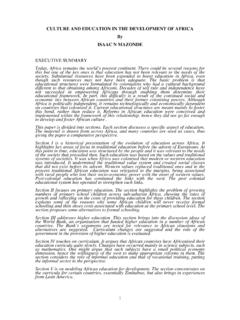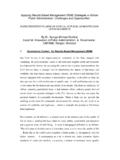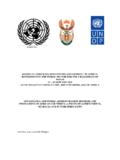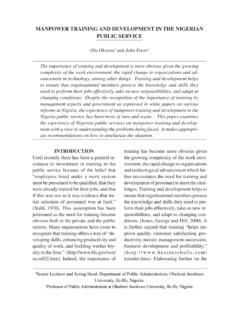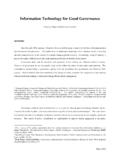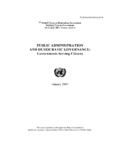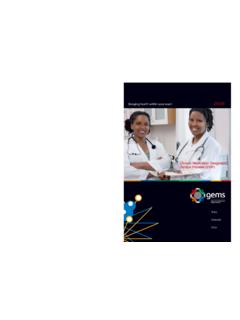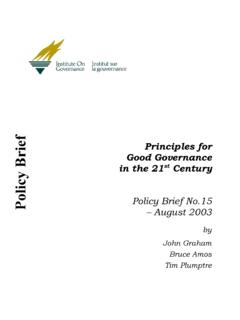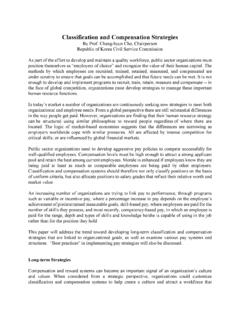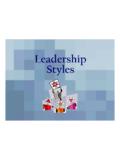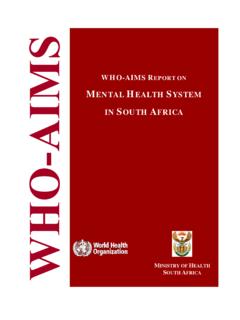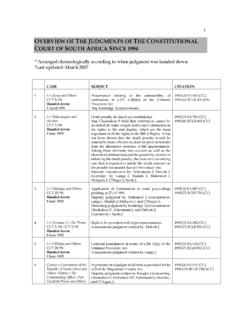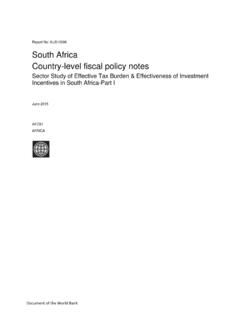Transcription of REPUBLIC OF SOUTH AFRICA - United Nations
1 REPUBLIC OF. SOUTH AFRICA . Public Administration Country Profile Division for Public Administration and Development Management (DPADM). Department of Economic and Social Affairs (DESA). United Nations January 2004. All papers, statistics and materials contained in the Country Profiles express entirely the opinion of the mentioned authors. They should not, unless otherwise mentioned, be attributed to the Secretariat of the United Nations . The designations employed and the presentation of material on maps in the Country Profiles do not imply the expression of any opinion whatsoever on the part of the Secretariat of the United Nations concerning the legal status of any country, territory, city or area or of its authorities, or concerning the delimitation of its frontiers or boundaries. Table of Contents Table of 1. SOUTH AFRICA .. 2. 1. General Information .. 3. 3. Economy .. 3. Public Spending.
2 4. Public Sector Employment and 4. 2. Legal Structure .. 5. Legislative 5. Executive Branch .. 6. Judiciary Branch .. 6. Provincial 7. Local 7. 3. The State and Civil Society .. 8. Ombudsperson .. 8. NGOs .. 8. Civil Society .. 8. 4. Civil Service .. 9. Legal 9. Recruitment ..10. Remuneration ..10. 5. Ethics and Civil Service ..14. Corruption ..14. 6. e-Government ..17. e-Government Readiness ..17. e-Participation ..18. 7. Links ..19. National sites ..19. Miscellaneous 1. SOUTH AFRICA . SOUTH AFRICA Click here for detailed map Government type REPUBLIC Independence 31 May 1910 (from UK);. SOUTH AFRICA became a REPUBLIC in 1961 following an October 1960. referendum. Constitution 10 December 1996;. certified by the Constitutional Court on 4. December 1996, signed by then President MANDELA. on 10 December 1996, and entered into effect on 3. February 1997 (in brief). Legal system Based on Roman-Dutch law and English common Source: The World Factbook SOUTH AFRICA law; accepts compulsory International Court of SOUTH AFRICA held its first democratic elections in Justice jurisdiction, with 1994, bringing to an end the apartheid regime.
3 Reservations The second, in June 1999, confirmed the African National Congress (ANC) majority. Thabo Mbeki, Administrative divisions who replaced Nelson Mandela as leader of the 9 provinces; Eastern Cape, ANC in 1997, became President. With just under Free State, Gauteng, a two-thirds majority in Parliament, the ANC. KwaZulu-Natal, Limpopo, governs seven out of nine provinces and is part Mpumalanga, North-West, of the coalition governing the two remaining Northern Cape, Western provinces. In 1999 the Democratic Party (DP). Cape and New National Party (NNP) together formed Source: The World Factbook . the Democratic Alliance (DA), the official SOUTH AFRICA opposition in Parliament until internal conflicts forced a separation. The first elections of the 284 newly demarcated local governments took place in December 2000. Local governments are entrusted with rising responsibility for providing access to services and enhancing the economic and social well being of communities within their constituencies.
4 Source: European Commission - RSA. 2. 1. General Information People SOUTH AFRICA Nigeria Tanzania 1. Population a Total estimated population (,000), 2003 45,026 124,009 36,977. Female estimated population (,000), 2003 23,023 61,558 18,661. Male estimated population (,000), 2003 22,003 62,451 18,316. Sex ratio (males per 100 females), 2003 96 101 98. Average annual rate of change of pop. (%), 2000-2005 Youth and Elderly Population b Total population under age 15 (%), 2003 33 44 45. Female population aged 60+ (%), 2003 7 5 4. Male population aged 60+ (%), 2003 5 5 4. Human Settlements c Urban population (%), 2001 58 45 33. Rural population (%), 2001 42 54 67. Urban average annual rate of change in pop. (%), 00- 05 Rural average annual rate of change in pop/ (%), 00- 05 Education d Total school life expectancy, 2000/2001 .. 5 1. Female school life expectancy, 2000/2001 .. 5 1. Male school life expectancy, 2000/2001.
5 1. Female estimated adult (15+) illiteracy rate (%), 2000 2. Male estimated adult (15+) illiteracy rate (%), 2000 14 2. Employment e Unemployment rate (15+) (%), 1997 .. 1. Female adult (+15) economic activity rate (%), xxxx 50ii 37iii .. 2. Male adult (+15) economic activity rate (%), xxxx 80ii 78iii .. 2. i Notes: Based on registered unemployment from employment office records, Whites, Coloured and Asians. Excluding Transkei, Bophuthatswana, Venda, Ciskei, Kwazulu, KaNgwane, Qwa Qwa, Gazankulu, Lebowa and KwaNdebele; ii 1991, Age 20+ years; iii 1986, Excluding institutional households, armed forces and persons doing unpaid community or social work Economy SOUTH AFRICA Nigeria Tanzania 2. GDP a GDP total (millions US$), 2002 104,235 43,540 9,383i GDP per capita (US$), 2002 2,392 328 267i i PPP GDP total (millions int. US$), 2002 441,573 112,947 19,589ii i PPP GDP per capita(int. US$), 2002 10,132 851 557ii Sectors b Value added in agriculture (% of GDP), 2003 Value added in industry (% of GDP), 2003 Value added in services (% of GDP), 2003 Miscellaneous c GDP implicit price deflator (annual % growth), 2003 Private consumption (% of GDP), 2003 Government consumption (% of GDP), 2003 Notes: i Estimate is based on regression; other PPP figures are extrapolated from the latest International Comparison Programme benchmark estimates; ii Data refer to mainland Tanzania only; iii 2002.
6 1. United Nations Statistics Division: a Statistics Division and Population Division of the UN Secretariat; b Statistics Division and Population Division of the UN. Secretariat; c Population Division of the UN Secretariat; d1 UNESCO ; d2 UNESCO; e1 ILO; e2 ILO/OECD. 2. World Bank - Data and Statistics: a Quick Reference Tables; b Data Profile Tables ; c Country at a Glance 3. Public Spending SOUTH AFRICA Nigeria Tanzania Public expenditures 3. Education (% of GNP), 1985-1987 .. a Education (% of GNP), 1995-1997 .. a Health (% of GDP), 1990 1 Health (% of GDP), 1998 Military (% of GDP), 1990 2ii b Military (% of GDP), 2000 b Total debt service (% of GDP), 1990 .. Total debt service (% of GDP), 2000 Notes: i Data refer to the central government only; ii 1991; iii 1999. Public Sector Employment and Wages Non- Middle Sub-Saharan Francophone income SOUTH AFRICA SOUTH AFRICA AFRICA Data from the latest year available AFRICA group 1991-1995 1996-2000 average4.
7 Average4 average4. 1996-2000. 1996-2000 1996-2000. Employment (,000) 564 .. Civilian Central Government5. (% pop.) .. (,000) 451 .. Sub-national Government5. (% pop.) .. (,000) 250 .. Education employees (% pop.) .. (,000) 93 .. Health employees (% pop.) .. (,000) .. Police (% pop.) .. (,000) 148 Armed forces (% pop.) (,000) .. SOE Employees (% pop.) .. (,000) .. Total Public Employment (% pop.) .. Wages Total Central gov't wage bill (% of GDP) .. Total Central gov't wage bill (% of exp) Average gov't wage (,000 LCU) .. Real ave. gov't wage ('97 price) (,000 LCU) .. Average gov't wage to per capita GDP ratio .. Source: World Bank - Public Sector Employment and Wages 3. UNDP - Human Development Report 2002. a Data refer to total public expenditure on education, including current and capital expenditures. b As a result of a number of limitations in the data, comparisons of military expenditure data over time and across countries should be made with caution.
8 For detailed notes on the data see SIPRI (2001). 4. Averages for regions and sub regions are only generated if data is available for at least 35% of the countries in that region or sub region. 5. Excluding education, health and police if available (view Country Sources for further explanations). 4. 2. Legal Structure The Constitution of the REPUBLIC of SOUTH AFRICA , 1996 (Act 108 of 1996), was approved by the Constitutional Court (CC) on 4 December 1996 and took effect on 4. February 1997. The Constitution is the supreme law of the land. No other law or government action can supersede the provisions of the Constitution. Government is constituted as national, provincial and local spheres, which are distinctive, interdependent and interrelated. The powers of the law-makers (legislative authorities), governments (executive authorities) and courts (judicial authorities) are separate from one another.
9 Source: SOUTH AFRICA Yearbook 2002/03. Legislative Branch Bicameral Parliament consisting of the National Assembly (400 seats; members are elected by popular vote under a system of proportional representation to serve five-year terms) and the National Council of Provinces (90 seats, 10 members elected by each of the nine provincial legislatures for five-year Women in parliament: Lower 119 out of 399 seats: (30%). 17 out of 89 seats (32%).7. Parliament is the legislative authority of SOUTH AFRICA and has Fact box: the power to make laws for the country in accordance with the elections: National Constitution. It consists of the National Assembly and the Assembly and National National Council of Provinces (NCOP). Council of Provinces - last held 2 June 1999 (next to The National Assembly consists of no fewer than 350 and no be held by 14 April 2004)8. more than 400 members elected through a system of election results: National proportional representation.)
10 The National Assembly, which is Assembly - percent of vote elected for a term of five years, is presided over by a Speaker, by party - ANC , DP. assisted by a Deputy Speaker. The National Assembly is , IFP , NNP , elected to represent the people and to ensure democratic UDM , ACDP , FF. , other ; seats by governance as required by the Constitution. It does this by party - ANC 266, DP 38, electing the President, by providing a national forum for public IFP 34, NNP 28, UDM 14, consideration of issues, by passing legislation, and by ACDP 6, FF 3, other 11;. scrutinizing and overseeing executive action. National Council of The NCOP consists of 54 permanent members and 36 special Provinces - seats by party - ANC 61, NNP 17, FF 4, IFP. delegates, and aims to represent provincial interests in the 5, DP. national sphere of government. Delegations from each province consist of 10 representatives. The NCOP gets a mandate from the provinces before it can make certain decisions.
